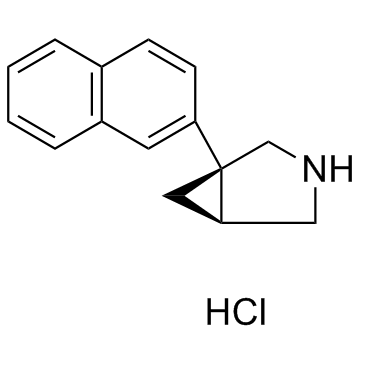Centanafadine hydrochloride
Modify Date: 2025-08-27 19:50:34

Centanafadine hydrochloride structure
|
Common Name | Centanafadine hydrochloride | ||
|---|---|---|---|---|
| CAS Number | 923981-14-0 | Molecular Weight | 245.747 | |
| Density | N/A | Boiling Point | N/A | |
| Molecular Formula | C15H16ClN | Melting Point | N/A | |
| MSDS | N/A | Flash Point | N/A | |
Use of Centanafadine hydrochlorideCentanafadine (hydrochloride) is dual norepinephrine (NE)/dopamine (DA) transporter inhibitor, also inhibits serotonin transporter, with IC50s of 6 nM, 38 nM and 83 nM for human NE, DA and serotonin transporter , respectively. |
| Name | Centanafadine hydrochloride |
|---|---|
| Synonym | More Synonyms |
| Description | Centanafadine (hydrochloride) is dual norepinephrine (NE)/dopamine (DA) transporter inhibitor, also inhibits serotonin transporter, with IC50s of 6 nM, 38 nM and 83 nM for human NE, DA and serotonin transporter , respectively. |
|---|---|
| Related Catalog | |
| Target |
IC50: 6 nM (human NE), 38 nM (human DA), 83 nM (human serotonin)[1]. |
| In Vitro | Centanafadine (EB-1020) preferentially inhibits monoamine reuptake in cloned cell lines transfected with human transporters with IC50 values of 6 and 38 nM, respectively, for NE and DA transporters, Centanafadine has lesser effects on 5-HT transporter as it inhibits the reuptake of 5-HT with an IC50 value of 83 nM [1]. |
| In Vivo | In microdialysis studies, Centanafadine markedly increases NE, and DA concentrations levels in rat prefrontal cortex in vivo with peak increases of 375 and 300%, respectively with the greatest effects on NE, and also increases DA extracellular concentrations in the striatum to 400% of baseline concentrations. Behavioral studies demonstrate that Centanafadine dose-dependently decreases immobility in the mouse tail suspension test of depression to 13% of control levels, and do not stimulate locomotor activity in adult rats in the optimal dose range. Centanafadine dose-dependently inhibits locomotor hyperactivity in juvenile rats lesioned with the neurotoxin 6-hydroxydopamine (100 μg intracisternally) as neonates; a well-established animal model for attention-deficit hyperactivity disorder (ADHD)[1]. |
| References |
| Molecular Formula | C15H16ClN |
|---|---|
| Molecular Weight | 245.747 |
| Exact Mass | 245.097122 |
| InChIKey | ACVMJAJGCQUPKX-LIOBNPLQSA-N |
| SMILES | Cl.c1ccc2cc(C34CNCC3C4)ccc2c1 |
| (1R,5S)-1-(2-Naphthyl)-3-azabicyclo[3.1.0]hexanhydrochlorid (1:1) |
| EB-1020 |
| 3-Azabicyclo[3.1.0]hexane, 1-(2-naphthalenyl)-, (1R,5S)-, hydrochloride (1:1) |
| (1R,5S)-1-(2-Naphtyl)-3-azabicyclo[3.1.0]hexane, chlorhydrate (1:1) |
| UNII:265DN9X85W |
| (1R,5S)-1-(2-Naphthyl)-3-azabicyclo[3.1.0]hexane hydrochloride (1:1) |
| (1R,5S)-1-(naphthalen-2-yl)-3-azabicyclo[3.1.0]hexane hydrochloride |
| DOV 216,419 |
| Centanafadine hydrochloride |